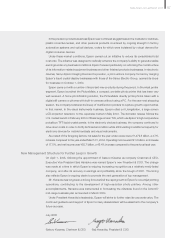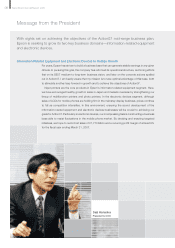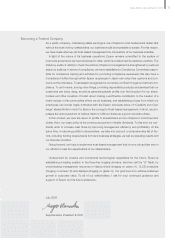Epson 2005 Annual Report Download - page 5
Download and view the complete annual report
Please find page 5 of the 2005 Epson annual report below. You can navigate through the pages in the report by either clicking on the pages listed below, or by using the keyword search tool below to find specific information within the annual report.
06 Seiko Epson Annual Report 2005
Saburo Kusama
Chairman & CEO
To Our Stakeholders
Following Saburo Kusama’s appointment as Chairman & CEO, former Executive Vice President
Seiji Hanaoka was named President & COO of Seiko Epson Corporation on April 1, 2005.
Headed by this new management team, Epson aims to further enhance its corporate value.
Seiji Hanaoka
President & COO
Results of Operations
Epson’s main markets consist of information-related equipment—an area that includes inkjet print-
ers and 3LCD projectors—electronic devices and precision products.
In the inkjet printer business, multifunction (all-in-one) printers continued to gain market share. In
the single-function printer business, demand grew for photo printers and small-format photo printers,
especially in the United States and European markets. The color laser printer market expanded, but
unit prices further declined.
The projector market grew on heightened demand for these products in the education segment
and in the Japanese and European home theater segment, as well as in the traditional business
presentation projector segment. On the other hand, however, prices resumed their slide in the
second half of the year, after having shown signs of bottoming out in the first half. The market for
microdevice-based projection TVs, which are more cost-competitive than flat-panel large-screen
TVs, sharply expanded in the U.S.
The market for electronic devices used in mobile phones remained firm. This strength came from
two main sources. One was replacement demand from consumers, especially those in Europe,
North America and China, who are upgrading from their old monochrome-display handsets to
models with color displays and built-in cameras. The other source was continued robust demand
for new models in such emerging markets as Central and South America, India, and Russia.


















